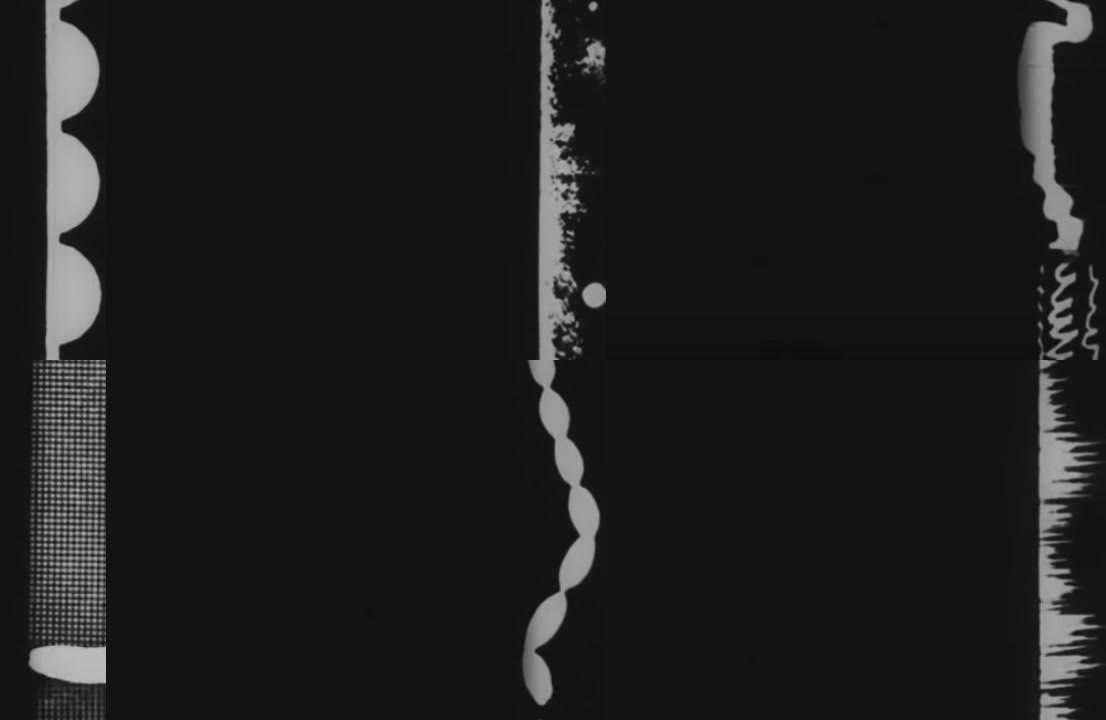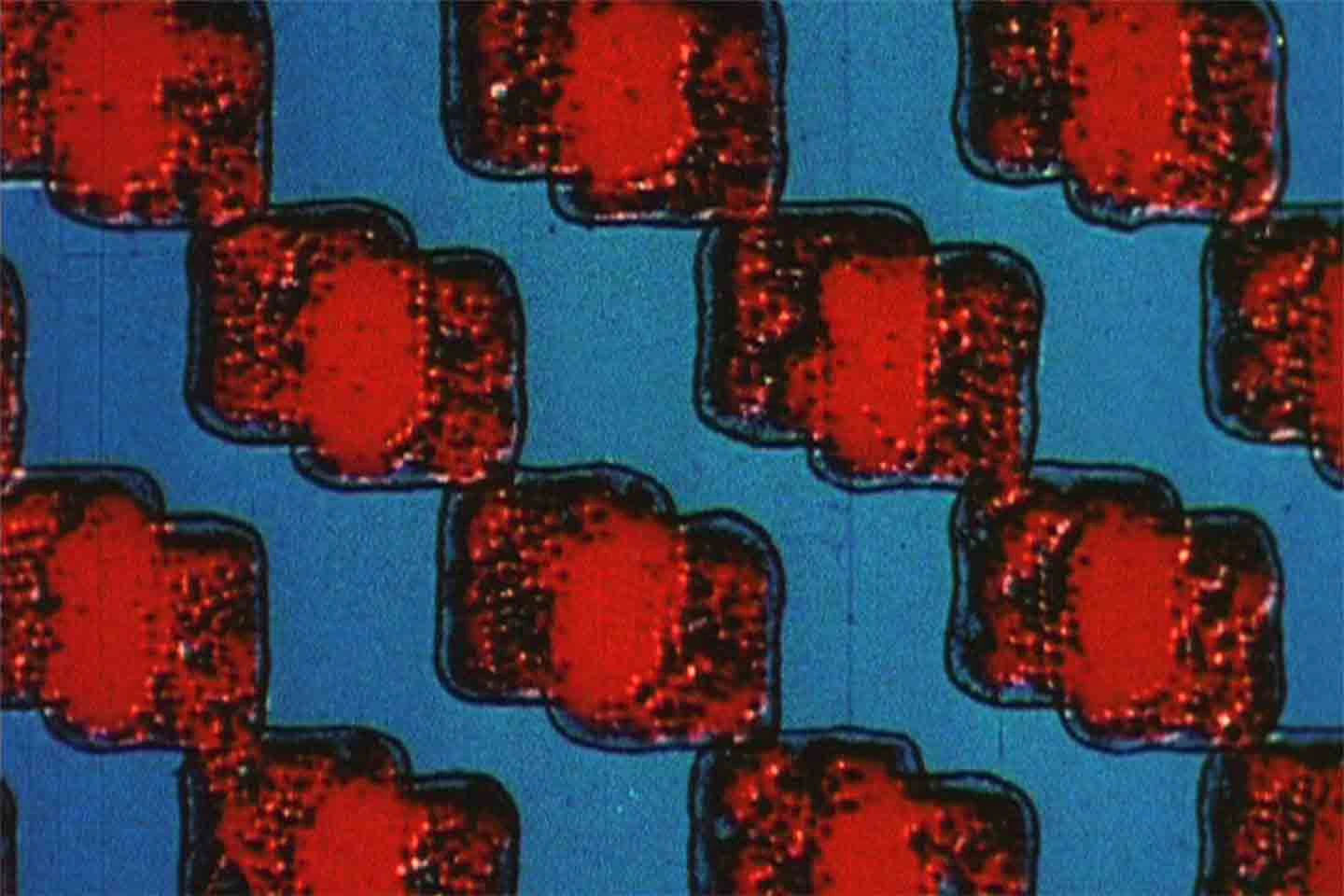

Por un daño ocasionado en una de las películas que conforman Light Music de Lis Rhodes, hemos añadido dos nuevos títulos al programa manteniendo Dresden Dynamo como eje central. Proponemos por tanto una obra histórica y otra de reciente creación que ahonden en la relación directa y no jerárquica entre imagen y sonido a través de distintas técnicas de intervención y manipulación del soporte fílmico.
László Moholy-Nagy
ABC in Sound (1933) / 1’ 55'' / 16 mm
Desaparecida durante más de 80 años, esta película fue encontrada por los conservadores del BFI dentro de un rollo de película de los Early Experiments in Hand Drawn Sound de Oskar Fischinger. Moholy-Nagy experimentó con las propiedades formales del cine, y en particular con el sonido óptico, difuminando las fronteras entre el sonido y la imagen, entre el acto de oír y el de ver el sonido. En ABC in Sound el artista interviene directamente la banda óptica de la película, trazando formas que el proyector transforma en sonido. Cada forma visible se convierte en un sonido propio: imagen y audio se generan simultáneamente, sin mediación de instrumentos o grabaciones convencionales.
Lis Rhodes
Dresden Dynamo (1971) / 5' / 16 mm
Dresden Dynamo es una obra sin cámara en la que, «aplicando transferencias Letratone y Letraset directamente a una película transparente de 16 mm descubrió que un determinado grado de Letratone producía el sonido de un do medio, un descubrimiento que le permitió componer una banda sonora de tonos musicales discernibles en relación con este tono tónico. Se crearon copias negativas y positivas a partir de la película original, que posteriormente se pasaron por filtros de color para crear el vibrante trío de tonos negros, rojos y azules que conforman la pista visual».
Hangjun Lee
The Metaphysic of sound (2007) / 25' / 16 mm
En Metaphysics of Sound, Lee trabajó directamente sobre película de 16 mm, dibujando y transfiriendo imágenes de bandas sonoras de 35 mm y collages de imágenes encontradas. La película fue editada en base a los patrones dibujados en el margen óptico, de modo que cada forma visual generase un sonido y, a su vez, el sonido organizase la estructura de la imagen. Así, Lee invierte la relación tradicional entre ver y oír, explorando el celuloide como un espacio donde la imagen es sonido y el sonido es imagen.

In response to the sudden fact thay one of the films that make up Lis Rhodes' Light Music had been damaged, we have added two new titles to the programme, maintaining Dresden Dynamo as the core piece of this first session. We propose a historical and a recent work that explore the direct and non-hierarchical relationship between image and sound through different techniques of intervention and manipulation of film.
László Moholy-Nagy
ABC in Sound (1933) / 1’ 55'' / 16 mm
Lost for more than 80 years, this film was found by BFI conservators inside a reel of Oskar Fischinger's Early Experiments in Hand Drawn Sound. Moholy-Nagy experimented with the formal properties of cinema, and in particular with optical sound, blurring the boundaries between sound and image, between the act of hearing and that of seeing sound. In ABC in Sound, the artist directly intervenes on the film's optical track, tracing shapes that the projector transforms into sound. Each visible shape becomes its own sound: image and audio are generated simultaneously, without the mediation of conventional instruments or recordings.
Lis Rhodes
Dresden Dynamo (1971) / 5' / 16 mm
Dresden Dynamo is a cameraless work in which by “applying Letratone and Letraset transfers straight to clear 16mm film stock she discovered that a certain grade of Letratone produced the sound of a middle C, a discovery that allowed her to compose a soundtrack of discernible musical tone tones relative to this tonic tone. Negative and positive copies were created from the original filmstrip and these were later passed through colour filters to create the vibrant black, red and blue triumvirate of tones that make the visual track”
Hangjun Lee
The Metaphysic of sound (2007) / 25' / 16 mm
In Metaphysics of Sound, Lee worked directly on 16 mm film, drawing and transferring images from 35 mm soundtracks and collages of found images. The film was edited based on the patterns drawn in the optical margin, so that each visual shape generated a sound and, in turn, the sound organised the structure of the image. Thus, Lee reverses the traditional relationship between seeing and hearing, exploring celluloid as a space where image is sound and sound is image.